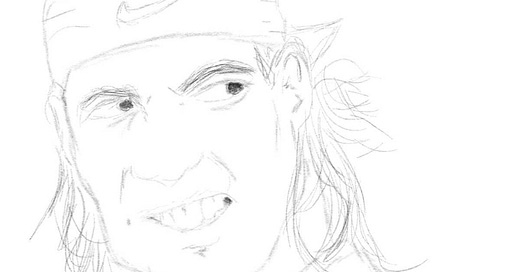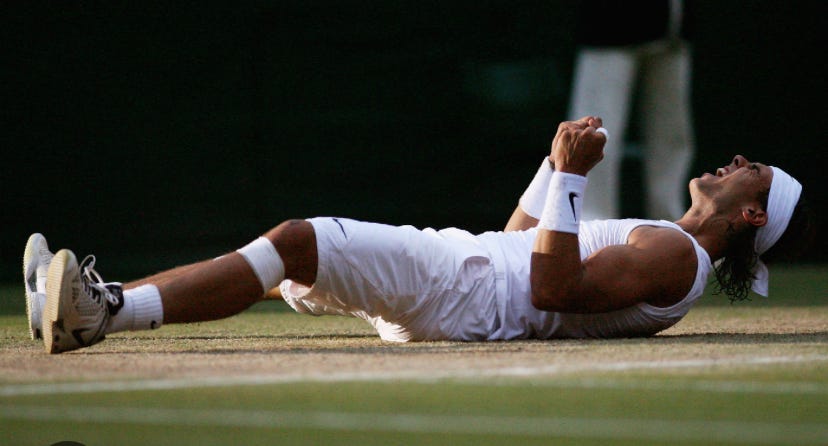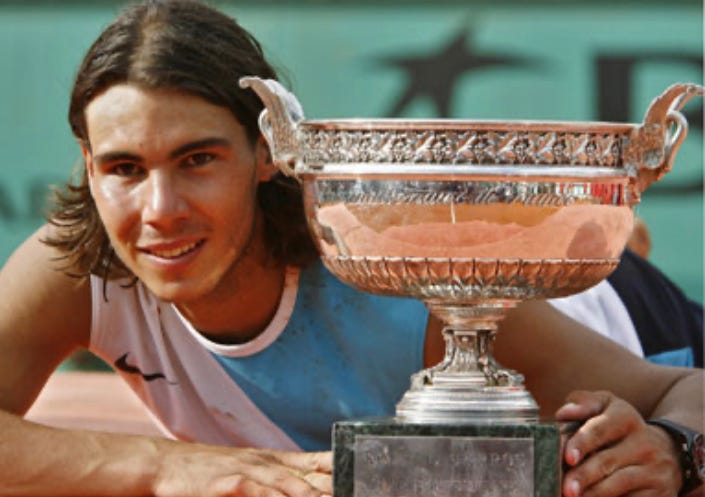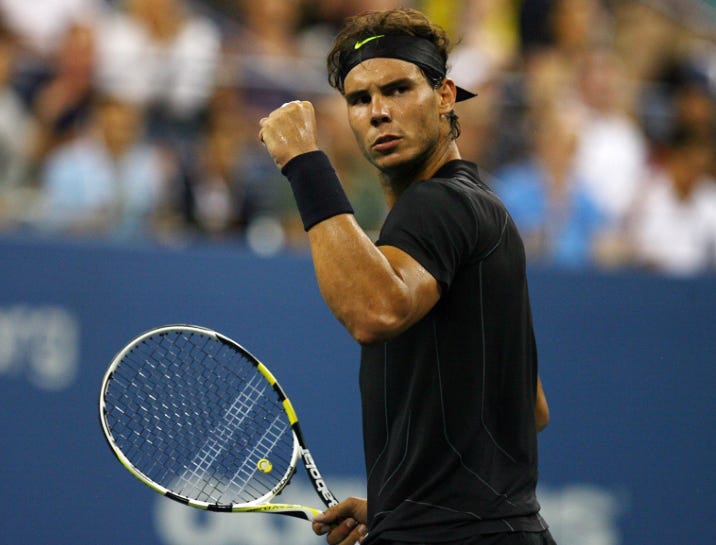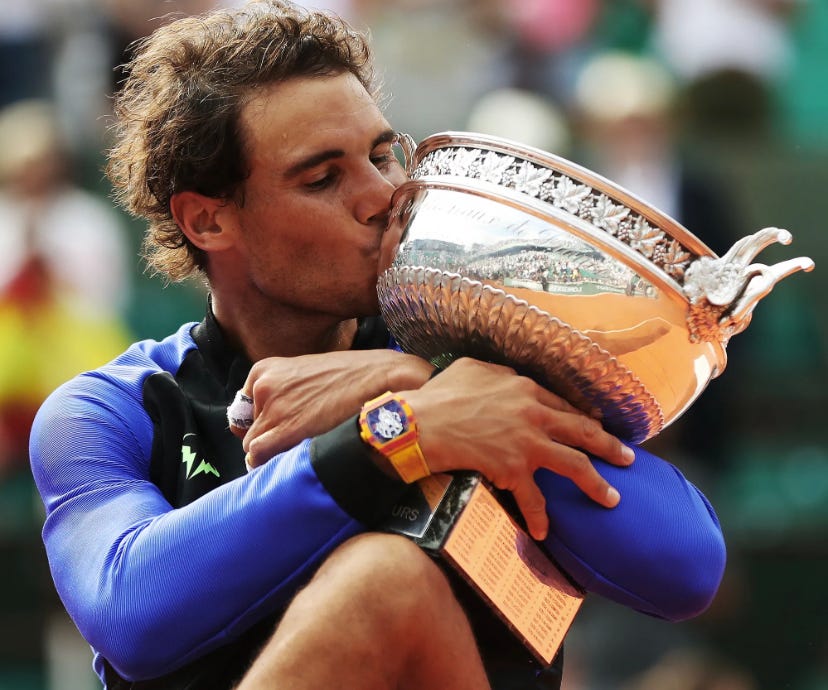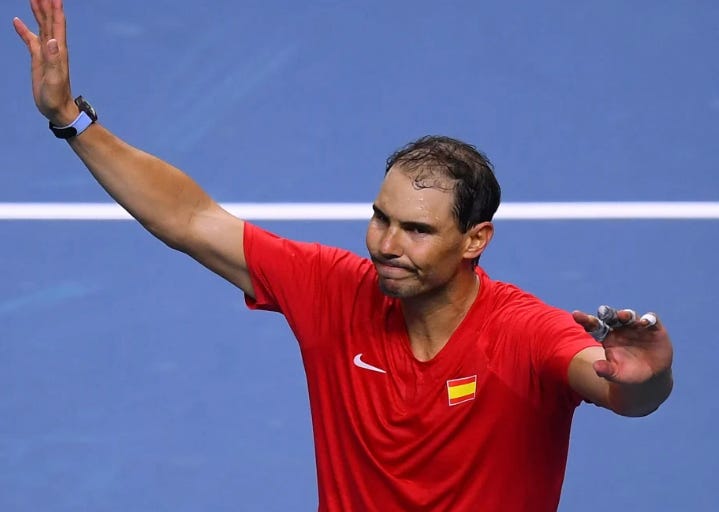21st Century Greats: Rafael Nadal
As the French Open continues, we look back at the career of the greatest clay court player of all time.
Over the course of the year, I will be posting biographies of 25 modern sporting greats to celebrate being a quarter way through the 21st Century. As usual, these posts will combine a summary of some of their sporting achievements mixed with my own memories of watching them. There is no order to the list, just a celebration of fantastic sportspeople.
21st Century Greats: Rafael Nadal
On the 6th July 2008 at just after 9pm and with darkness setting in all around, Rafael Nadal collapsed to the ground, lay down on his back and thrust out his fists in delight. He had just taken part in the greatest tennis match in history and had beaten his nemesis Roger Federer to win his first Wimbledon title.
Federer had won the previous five editions of the event and was on a 65 match winning streak on grass at the time but over 4 hours and 48 minutes of court time (and a number of rain delays) Nadal battled as hard as he could and finally beat the grass court god. The crowd went wild as the two men came to shake hands at the net before Nadal turned to soak in the adulation, head in hands, still not quite able to believe what he had achieved.
The master of clay had finally won a major on grass, only the third man to win the French Open and Wimbledon back-to-back in the Open Era after Rod Laver and Bjorn Borg. He had fought hard to do so, winning 9-7 in the fifth set after having been defeated by Federer in the final in the two previous years. It was now clear that Nadal was not just a one surface wonder and could deal with the best on any surface when it really mattered.
Growing up on the island of Mallorca, Nadal was keen on both tennis and football. His uncle, Miguel Angel Nadal, was a great for both Barcelona and Spain, but his other uncle, Toni, encouraged him to pick up a tennis racket. Toni was hard on the young Rafa but this helped him to improve. He was soon winning tournaments and the taste of success was what finally helped him to make his decision on which sport to fully focus on. Those around him knew he was good, but perhaps not how good he was actually going to become.
Tenacity is a good word to describe the Spaniard. One of the best returners to ever play the game, Nadal never knew when a point was done, moving from side-to-side along the baseline and pummelling opponents into submission with an endless array of powerful shots. His topspin forehand was a dominant stroke that allowed him to stay on the front foot against many an opponent but even when hustling he was incredibly dangerous.
These qualities allowed him to become incredibly difficult to beat, particularly on clay. Over his career, Nadal won 92 ATP singles titles, 63 of which were on his favoured surface. This included a record 14 French Open titles, only losing twice at the event between 2005 (when he won on debut) and 2020 - he also retired due to injury once in 2016.
Nadal had won four straight titles at Roland Garros when he was surprisingly beaten by Robin Soderling in the fourth round in 2009. It sent shockwaves through the tournament, the great clay master finally defeated. However, shortly after the defeat it became clear that Nadal had been struggling with tendinitis in his knees and he eventually chose not to defend his Wimbledon title or play in the Davis Cup at that point (he would later play a role in Spain’s final victory).
Earlier in 2009 he had won his first hard court major tournament at the Australian Open. He became the first Spaniard to win that title. At the US Open, he looked to continue his fine form on hard courts and, returning from injury, he made it to the semi finals against Juan Martin Del Potro. In the end, the Argentine defeated Nadal fairly convincingly in straight sets before going on to defeat Federer in the final. However, Nadal was now very comfortable on all surfaces as would be shown in the following year.
2010 was a standout for Nadal as he won three majors across all three surfaces, reclaimed the world number one spot and became the youngest man to achieve the Career Grand Slam in winning the US Open in September aged only 24 years and 101 days. This was a fitting reward, even at this relatively early stage of his glittering career.
The year had started solidly but not spectacularly as Nadal reached the quarter finals of the Australian Open before retiring through injury against Andy Murray. He reached semi finals and finals in other tournaments before winning the Monte Carlo event for his first tour win in 11 months. This started a winning streak and he won again at the Italian Open and the Madrid Masters before heading back to Roland Garros.
Nadal didn’t need any help on clay but the draw was kind to him and he romped through the rounds without losing a set having not faced anyone inside the world’s top 16 along the way. In the final he came up against Soderling again, the man who had handed him his first ever French Open defeat a year previously. Revenge was sweet for Nadal as he stormed to another straight sets victory to win the tournament for the fifth time.
The Spaniard faced Soderling once more in the quarter finals at Wimbledon and this time took down the Swede in four sets before going on to win the tournament for the second time. It wasn’t the easy run that he had experienced at Roland Garros though as he had needed five sets to get through in both the third and fourth rounds. This showed Nadal’s continued grit and spirit when things were tough.
When he defeated Djokovic in the final of the US Open to complete his Career Golden Slam, he also became the first man ever to win major tournaments on all three surfaces in the same year. It was also his third major in a row which set him up for an opportunity to hold all of them at the same time when the Australian Open came around at the beginning of the following year. For that moment though, Nadal could enjoy the achievements of the year, one that proved beyond all question that he was a force on all surfaces and not just on his favoured clay.
Nadal’s quest to win four majors in a row ended at the quarter final stage of the Australian Open in 2011 where he suffered from a hamstring injury. He did go on to win his sixth French Open crown but lost his Wimbledon title to Novak Djokovic. He lost to the same man in the final of the US Open but did go on to win the Davis Cup with Spain that year.
Between 2012 and 2020, Nadal continued at the very top of the sport and won 10 more major titles (7 at the French Open and 3 at the US Open). This streak included another match for the ages against Djokovic in the semi finals of the French Open in 2013 where Nadal again showed grit to come from behind and win in five sets. During this period he also won another Olympic gold medal, this time in the doubles with partner Marc Lopez.
However, Nadal also missed a number of tournaments and major opportunities due to persistent injury concerns. These affected various different parts of his body including his knees, back and wrist. He also had a sustained period where he struggled for form. 2015 marked the first year in ten where he hadn’t won a major and in 2016 he didn’t even manage to make a quarter final in any of the four.
Form was rekindled in 2017 where he won both the French and US Open titles and regained the world number 1 ranking. This was a feat which he repeated in 2019. In that year he also helped Spain to its sixth Davis Cup title. He may not have been the complete physical specimen that he once was but he was still an incredible athlete capable of beating anyone else on the tour.
Nadal missed a large portion of the season in 2021 due to a foot injury but came back in 2022 like a man reborn. At the Australian Open he battled back from two sets down to beat Daniil Medvedev and become only the second man to win a double Career Grand Slam. This was his 21st major title and at that point he overtook Federer and Djokovic for the most major titles of all time.
In winning the French Open again later that year, he extended that record as well as reaching 112 victories at the event which became a record for a single major. That was to be his last major final and although he carried on for another couple of years he was ravaged by further injuries and a lack of form that came with this. His body just couldn’t perform at the highest level any more and, following a final Davis Cup appearance for Spain, Nadal retired in 2024.
Novak Djokovic may have eventually passed Nadal’s 22 major victories, but the Spaniard undoubtedly proved that he was one of the best to ever play the game. It seems inarguable that he is certainly the greatest clay court player of all time. Despite his numerous victories and tenacity and aggression on court, Nadal remained a humble man and he was never one to search for the spotlight.
His legacy will live on as part of the Big Four and also due to the tennis academies that he has set up in his name both on his home island of Mallorca and in other locations across the globe. We may never get to see tennis of a standard that we saw in the first quarter of this century again but we will always have the memories to look back on. Rafael Nadal was a huge part of that and truly a 21st Century Great.
Notable Achievements:
209 weeks as world number one
92 ATP singles titles - 63 on clay
36 Masters titles
14 French Open titles
4 US Open titles
2 Wimbledon titles
2 Australian Open titles
1 Olympic Games gold medal singles
1 Olympic Games gold medal - doubles
5-time Davis Cup winner
2nd all-time money earnings
One of three men to complete career golden slam (4 majors plus Olympics) with Djokovic and Agassi
81 consecutive wins on clay - longest single surface in Open Era

